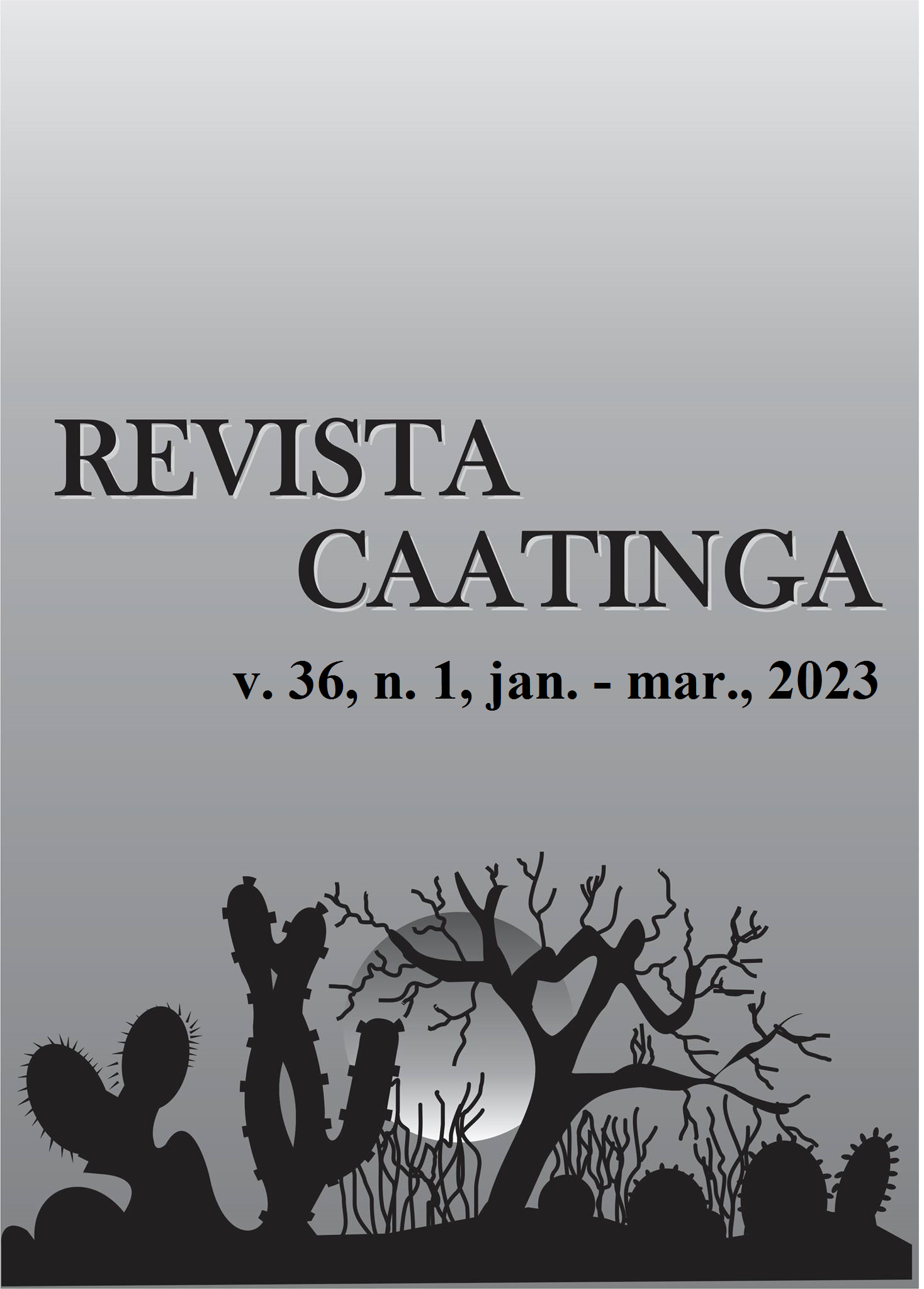Tomateiro cereja ornamental em diferentes ambientes protegidos e materiais refletores em bancada de cultivo
DOI:
https://doi.org/10.1590/1983-21252023v36n102rcPalavras-chave:
Condições microclimáticas. Radiação. Sombreamento. Luminosidade.Resumo
Objetivou-se com esse trabalho avaliar o crescimento de plantas ornamentais de tomateiro cereja em diferentes ambientes protegidos e materiais refletores sobre as bancadas de cultivo. Por não haver repetições dos ambientes protegidos, cada ambiente foi considerado um experimento. Em cada ambiente, o delineamento experimental utilizado foi o inteiramente casualizado com cinco repetições e três plantas por parcela. A partir das análises de variâncias individuais e avaliação dos quadrados médios dos resíduos menor que sete foi realizada a análise conjunta (três ambientes protegidos x três materiais refletores sobre a bancada de cultivo + 1 uma testemunha sem material). Os ambientes protegidos avaliados foram a estufa agrícola com tela de 42-50% de sombreamento sob o filme, o telado agrícola com tela preta de 30% de sombreamento e o telado agrícola com tela aluminizada de 35% de sombreamento. Os materiais refletores sobre a bancada de cultivo foram o Aluminet®, o laminado de fórmica branca e o laminado de fórmica vermelha. Os diferentes ambientes protegidos influenciaram no crescimento das plantas, sendo que em função da menor luminosidade incidente, as plantas apresentaram maior altura na estufa plástica. As bancadas refletoras não interferiram na altura de plantas, mas favoreceram a produção de frutos. Dentre os ambientes destaca-se a estufa plástica 42-50% de sombreamento. Para os materiais refletores na bancada, destacaram-se o material aluminizado e a fórmica vermelha, pois favoreceram o crescimento de plantas de tomateiro cereja com características ornamentais desejáveis, como maior produção de frutos.
Downloads
Referências
BANZATTO, D. A.; KRONKA, S. N. Experimentação agrícola. 4. ed. Jaboticabal, SP: Funep, 2013. 237 p.
BARROSO, P. A. et al. Analysis of segregating generation for components of seedling and plant height of pepper (Capsicum annuum L.) for medicinal and ornamental purposes. Acta Horticulturae, 953, 269-275, 2012.
CABRAL, R. C. et al. Material reflectante en bancos de cultivo y paja de arroz sobre el sustrato en la producción de plántulas de papaya. Revista Mexicana de Ciencias Agrícolas, 11: 1713-1723, 2020.
COSTA, E. et al. Growth of ornamental pepper in colored containers under protected environments. Agricultural Building and Environment. Engenharia Agrícola, 40: 581-588, 2020a.
COSTA, E. et al. Ambientes e substratos na formação de mudas e produção de frutos de cultivares de tomate cereja. Horticultura Brasileira, 33: 110-118, 2015.
COSTA, G. G. S. et al. Shading level, reflective material, and seeding depth on the growth of baru seedlings. Agricultural Engineering International: CIGR Journal, 22: 83-92, 2020b.
FERREIRA, D. F. SISVAR - Sistema de análise de variância. Versão 5.3. Lavras, MG: UFLA, 2010. 66 p.
FRANCA, R. J. F.; LEITÃO, M. M. V. B. R.; CAMPECHE, L. F. S. M. Produtividade do tomate cereja em ambiente protegido e céu aberto em função das lâminas e intermitências de irrigação. Revista Brasileira de Agricultura Irrigada, 11: 1364-1370, 2017.
HOLCMAN, E. Microclima e produção de tomate tipo cereja em ambientes protegidos com diferentes coberturas plásticas. 2009. 128 f. Dissertação (Mestrado em Ciências: Área de concentração em Física do Ambiente Agrícola) – Universidade de São Paulo, Piracicaba, 2010.
LIMA, A. H. F. et al. Pimenta ornamental em bancadas reflexivas colorida em diferentes ambientes protegidos em transição agroecológica. Cadernos de Agroecologia, 13: 1-10, 2018.
KERBAUY, G. B. Fisiologia vegetal. 2. ed. Rio de Janeiro, RJ: Guanabara Koogan, 2013. 431 p.
MOREIRA, B. P.; LOPES, S. A. O. R. Espécies nativas com potencial ornamental ocorrentes na bacia do rio taquarembó, RS. Congrega Urcamp, 15: 579-591, 2018.
MORTATE, R. K. et al. Levels of Shading and Reflective Material in Benches for Schizolobium amazonicum Seedlings. Journal of Agricultural Science, 11: 485-495, 2019.
PAULA, R. C. M. et al. Monitoramento de variáveis micrometeorológicas em diferentes ambientes protegidos no período de inverno. Revista de Agricultura Neotropical, 4: 103-109, 2017.
PEEL, M. C.; FINLAYSON, B. L., T. A. MCMAHON. Updated world map of the Köppen-Geiger climate classification. Hydrology and Earth System Sciences, 4: 1633-1644, 2007.
RODRIGUES, V. G. S.; GONZAGA, D. S. O. M. Preparo de receitas para o combate e controle de pragas com plantas medicinais. 4. ed. Porto Velho, RO: Embrapa Rondônia, 2001. 2 p.
SALLES, J. S.; LIMA, A. H. F.; COSTA, E. Mudas de jambolão sob níveis de sombreamento, bancadas refletoras e profundidade de semeadura. Revista de Agricultura Neotropical, 4: 110-118, 2017.
SANTOS, T. V. et al. Produção de mudas de maracujá amarelo com diferentes materiais refletores sobre bancada. Revista de Agricultura Neotropical, 4: 26-32, 2017.
TAIZ, L. et al. Fisiologia e desenvolvimento vegetal. 6. ed. Porto Alegre, RS: Artmed, 2017. 888 p.
Downloads
Publicado
Edição
Seção
Licença
Os Autores que publicam na Revista Caatinga concordam com os seguintes termos:
a) Os Autores mantêm os direitos autorais e concedem à revista o direito de primeira publicação, com o trabalho simultaneamente licenciado sob a Licença Creative Commons do tipo atribuição CC-BY, para todo o conteúdo do periódico, exceto onde estiver identificado, que permite o compartilhamento do trabalho com reconhecimento da autoria e publicação inicial nesta revista, sem fins comerciais.
b) Os Autores têm autorização para distribuição não-exclusiva da versão do trabalho publicada nesta revista (ex.: publicar em repositório institucional ou como capítulo de livro), com reconhecimento de autoria e publicação inicial nesta revista.
c) Os Autores têm permissão e são estimulados a publicar e distribuir seu trabalho online (ex.: em repositórios institucionais ou na sua página pessoal) a qualquer ponto antes ou durante o processo editorial, já que isso pode gerar alterações produtivas, bem como aumentar o impacto e a citação do trabalho publicado (Veja O Efeito do Acesso Livre).







